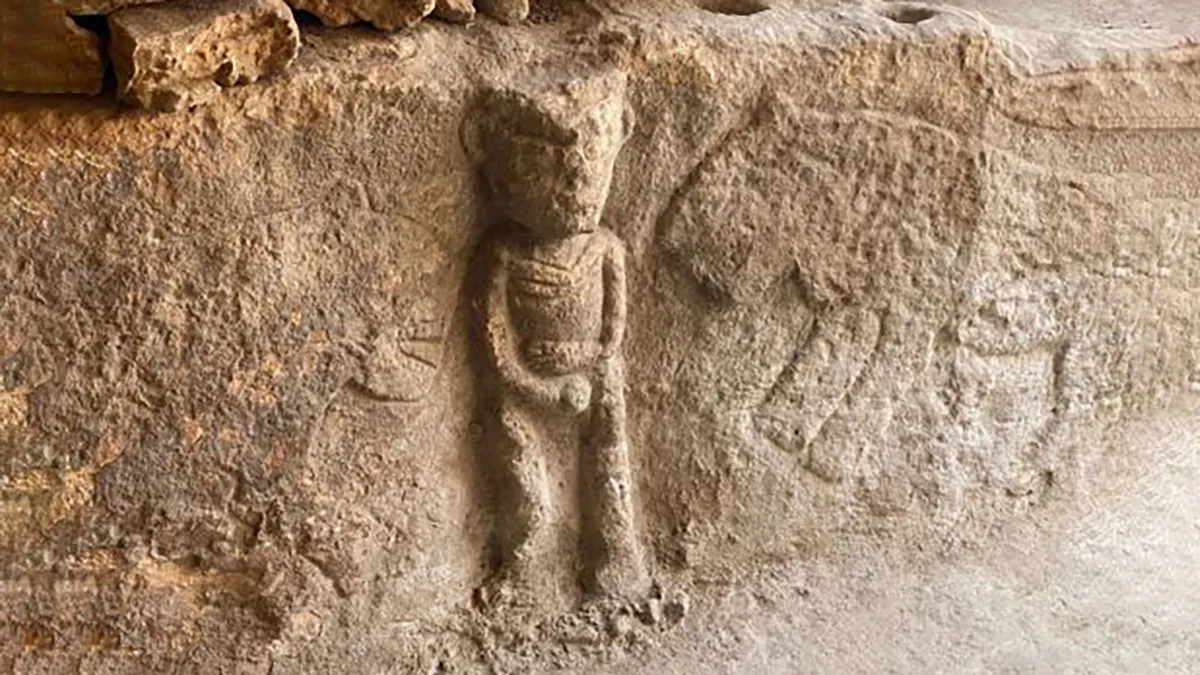What is it with humans and dicks? Freud was famously obsessed with phallic symbols. Urban warriors paint dicks on potholes to force councils to repair them. There’s a whole doodling board game dedicated to, well, drawing doodles on dicks.
The Australian Electoral Commission has even confirmed that drawing a dick on your ballot paper is, in fact, legal.
We humans are obsessed with dicks.
And we have been for a very, very long time.
Karahan Tepe in Turkey is one of the most ancient large-scale human settlements in the world, with temple structures dating back over 11,000 years.
And guess what archaeologists have found there?
Yep – dicks.
Archaeologists working at the ancient Karahan Tepe site in Turkey have made a spectacular find during their recent excavations: an enormous statue of a man who appears to be holding his phallus.
The statue, 7.5 feet tall, was found “fixed to the ground in a bench,” according to a statement from Turkey’s Ministry of Culture and Tourism. The statement further adds that the statue of the man holding his phallus is one of “the most impressive examples of prehistoric art” and that it has “a realistic facial expression” and emphasized “ribs, spine and shoulder bones.”
It’s really quite impressive, when you think about it. At the dawn of time, when humans were still mostly hunter-gatherers using stone tools, someone spent a lot of time and effort making a gigantic statue of a bloke rubbing one out.
Of course, the archaeologists are trying to play coy and make out that they’re “not sure” what it is (a bit like that Roman dildo they tried to pass off as a “darning tool”).
“Any interpretation of the statue is conjectural at this point,” Ted Banning, an anthropology professor at the University of Toronto who is not involved in the Karahan Tepe excavations told Live Science. Because the statue may represent a dead person, Banning added that it could be a depiction of “an important ancestor associated with the building in which it was found.”
“The fact that the figure is clutching its penis is also consistent with this interpretation by potentially symbolizing that this person was the progenitor of a social group, such as a lineage or clan, associated with the building.”
Smutty humour aside, though Karahan Tepe and its nearby sister site, Gobekli Tepe, are yielding incredible finds.
In addition to the discovery of the man holding his phallus, archaeologists also announced the discovery of a life-size wild boar statue that they unearthed at Gobekli Tepe, another ancient site 22 miles away that is thought to be home to the oldest temple in the world.
One of the most exciting things about the boar statue, according to the German Archaeological Institute, is that archaeologists can still detect traces of pigment on the stone, suggesting that it was once painted.
“Remarkably, the residues of red, black and white pigments still adhered to the statue’s surface,” the statement explained. “The tongue of the boar was coloured red, with black and white pigment found elsewhere on its body. Whereas experts have long presumed that pigments played a role in the decoration of statues and T-pillars at Gobekli Tepe, there is now unequivocal archaeological evidence for this assumption.”
Which fits in with what we know about statuary from the much-later Classical era in the Mediterranean. Far from the elegant white marble we’re used to seeing today, in fact, Roman and Greek statuary was routinely painted in almost gaudy colours.
What sites like Karahan Tepe are also revealing is that quite complex societies evolved in the cradle of civilisation far earlier than was long believed.
And that the main impetus for developing settled civilisation was not agriculture.
Both Karahan Tepe and Gobekli Tepe have challenged archaeologists’ understanding of ancient hunter-gatherer societies in recent years. As Live Science explains, experts once thought societies living in southwest Asia 11,000 years ago were simple and small in scale. But sites like Karahan Tepe and Gobekli Tepe, with their elaborate architecture and sculptures, suggest that ancient societies were complicated and organized.
Significantly, the existence of Gobekli Tepe suggests that religion may have come before agriculture and not the other way around, as many historians have long believed. Live Science reports that the ancient site was likely used by ancient people for funerary rituals.
All That’s Interesting
Indeed, one of the long-running mysteries of the neolithic revolution is why people even bothered with agriculture at all. In the ancient, warm climates, hunter-gatherer living was extremely easy. It took at most a few hours’ work to assemble a very healthy diet. By contrast, agriculture demanded long hours of backbreaking toil, for, at first, very marginal results.
Religion, it seems, changed everything.
Except our fascination with dicks.









